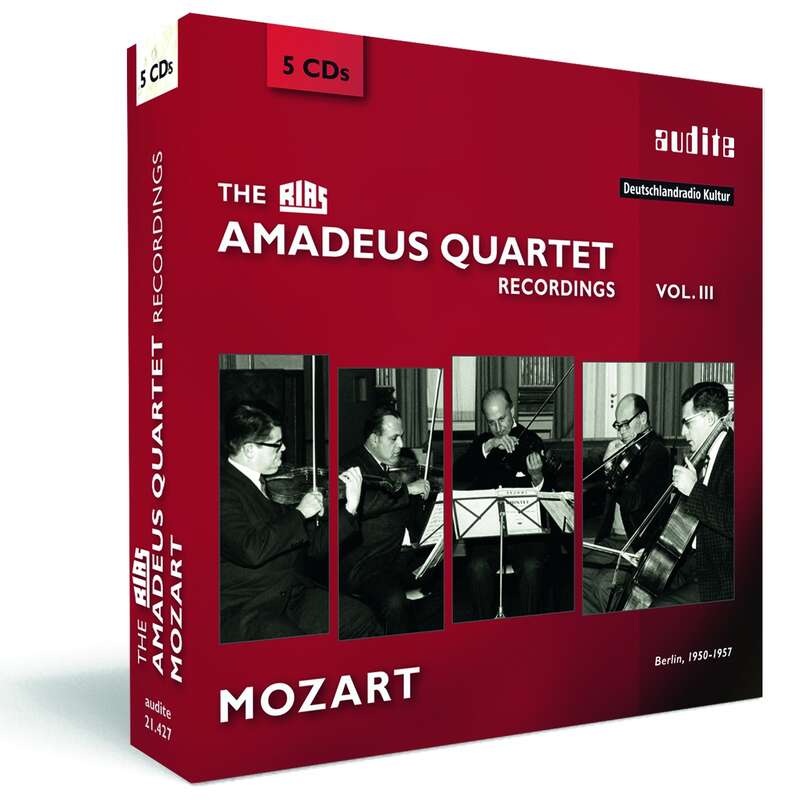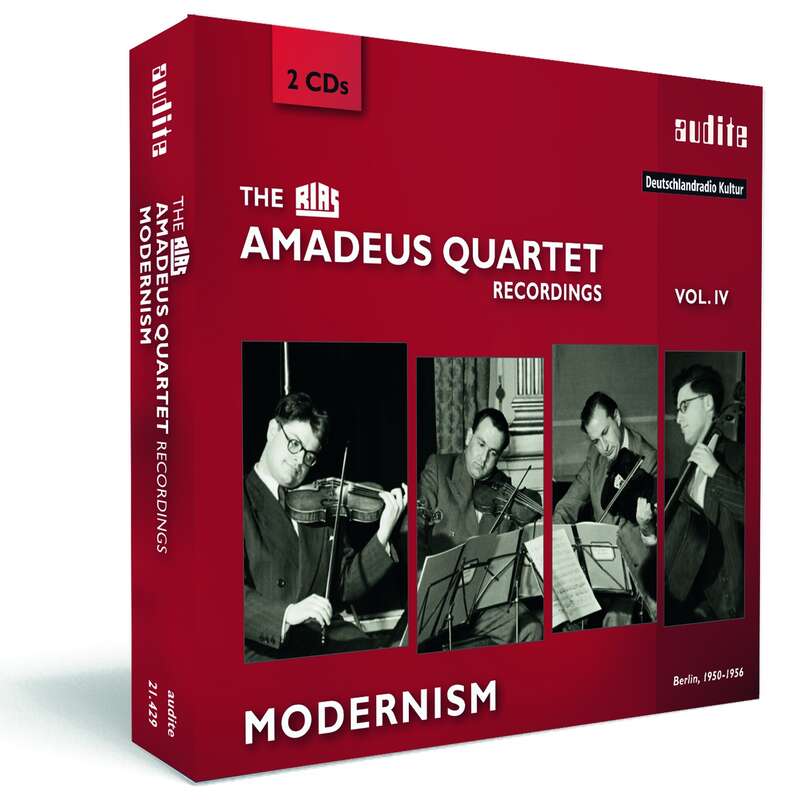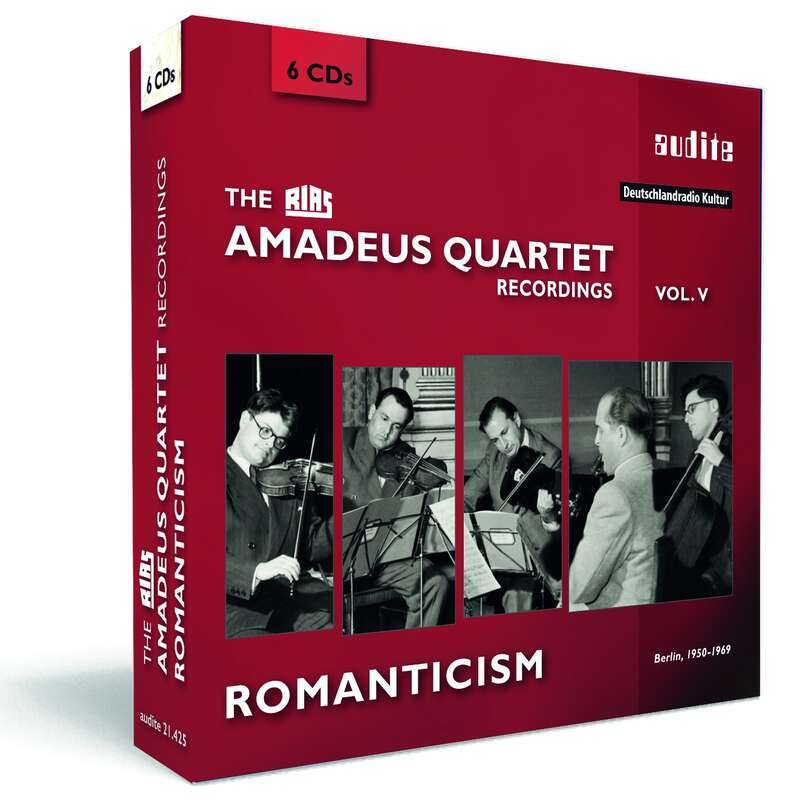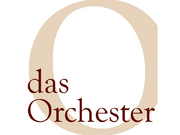Seit Beginn seiner Karriere kam das legendäre Amadeus-Quartett regelmäßig zu Aufnahmen in die Studios des RIAS Berlin. So entstand über 20 Jahre ein repräsentativer Repertoirequerschnitt des Ensembles im dortigen Archiv, den audite in insgesamt sechs Bänden veröffentlicht. Am Beginn dermehr
Die Streichquartette ihres Namensgebers Mozart waren dem Amadeus-Quartett von Beginn an eine Herzensangelegenheit. Die vorliegenden, bislang unveröffentlichten Aufnahmen aus den Archiven des Deutschlandradios sind im ersten Jahrzehnt des Bestehens des Quartetts entstanden. Sie zeigen das Ensemble bereits in den Anfangsjahren auf technisch und musikalisch höchstem Niveau. Ergänzt wird die Edition durch die Veröffentlichung der vier großen Streichquintette mit Cecil Aronowitz und des Klarinettenquintetts mit Heinrich Geuser. Über 20 Jahre hinweg entstand durch die regelmäßigen Besuche des Amadeus-Quartetts in den RIAS-Studios Berlin ein repräsentativer Repertoirequerschnitt des Ensembles im dortigen Archiv. audite veröffentlicht diese Aufnahmen in einer sechsteiligen Serie.
Titelliste
Multimedia
-
Producer's Comment
unmittelbare Eindrücke des Produzenten Ludger Böckenhoff
- DigiBooklet
- Producer's Comment
- digibooklet
- Digibooklet
-
Producer's comment
unmittelbare Eindrücke des Produzenten Ludger Böckenhoff
Informationen
Seit Beginn seiner Karriere kam das legendäre Amadeus-Quartett regelmäßig zu Aufnahmen in die Studios des RIAS Berlin. So entstand über 20 Jahre ein repräsentativer Repertoirequerschnitt des Ensembles im dortigen Archiv, den audite in insgesamt sechs Bänden veröffentlicht. Am Beginn der Reihe steht der (fast) komplette Beethoven-Zyklus, der in den Jahren von 1950 bis 1967 entstand und erstmals der Öffentlichkeit zugänglich gemacht wird. Die Einspielungen dokumentieren, wie sich das Amadeus-Quartett mit kontinuierlichem Anspruch den Beethoven'schen Quartettkosmos erarbeitet, aber auch die Entwicklung des Ensembles als Ganzes. Ähnliches gilt für die Auswahl der Streichquartette von Franz Schubert, die als Band 2 dieser Reihe erschienen sind. Die sechsteilige Serie "The RIAS Amadeus Quartet Recordings" wird noch durch ausgewählte Streichquartette Mozarts und Haydns (nicht mehr erhältlich) sowie die Sammelbände "Modernism" und "Romanticism" vervollständigt.
Besprechungen
www.musicweb-international.com | December 2017 | Jonathan Woolf | 1. Dezember 2017 | Quelle: http://www.music... Recording of the Year
Volume 5 in Audite’s survey of the Berlin broadcasts of the Amadeus Quartet is undoubtedly the most important yet. Works wholly new to theMehr lesen
www.musicweb-international.com | Tuesday November 14th | Jonathan Woolf | 14. November 2017 | Quelle: http://www.music...
The fifth volume in Audite’s superbly refurbished boxed series covers a two-decade period from 1950-69 during which time the Amadeus Quartet setMehr lesen
The first three CDs are largely given over to Brahms. In the case of the C minor Quartet, Op. 51 No. 1 the recording is slightly shrill in the strings’ upper register – this is something that is noticeable in a number of these earliest incarnations – though not enough to limit one’s enjoyment of the performances. What one may lose in this acidic quality is more than made up when the playing is so vitalised and dramatically purposeful. The tonal breadth of the Romanze survives any possible aural impediment. It’s the quality of refinement that demarcates the Op. 67 Quartet where one finds Norbert Brainin’s beautiful phrasing in the Andante one of the most distinguishing markers of excellence. The 1957 recording quality is decidedly warmer, aerating the ensemble’s textures to considerable advantage. A couple of days after the Op. 51 No. 1 performance the quartet returned to the radio studio to play the Piano Quintet in F minor, Op. 34 but not with one of their familiar colleagues, Clifford Curzon, but instead with Conrad Hansen. He is perfectly in tune with the conception, his own contribution being eminently well-balanced: playing of strong identity but selfless integration. Note his pizzicato-like paragraphs in the first movement, and the scaled question-and-response between the strings and piano, as well as the expressive inner voicings in the slow movement and the Scherzo’s sweep. In the beautifully phrased Clarinet Quintet, chronologically the last work in the box to have been composed, the Amadeus is joined by Heinrich Geuser. A distinguished orchestral principal, teacher and soloist he had a considerable influence on the succeeding generation of clarinets, one of whom – Karl Leister, the most famous German player of his generation – was later to record the Clarinet Quintet with the Amadeus.
For the String Quintet, Op. 111 they are joined by their violist of choice, Cecil Aronowitz, for a September 1953 performance of vivid communicative power where the rhythmic pointing in the finale is as persuasive as the elements of rusticity embedded in the music. The Bruckner Quartet is sonorously declaimed but they manage to locate the wit in the Scherzo that prefaces the sustained gravity of the Adagio. Though they performed Schumann’s chamber music in concert and for radio broadcast they never took any of the music into the studio, which makes the appearance of the Op.44 Piano Quintet and the A major Quartet, Op. 41 No. 3 so exciting. The former is again with Hansen in a performance dating from February 1962 notable for the flowing lyricism of the second movement and in the sensitive balance maintained in the finale. The A major’s fugal and rustic predilections are happily brought out, the country dance that courses through the finale being a particularly good example of the Amadeus’ art. The recording quality is generous enough to make the quartet sound more characteristically themselves here than in some of the earliest readings. Even in a box this fine, disc four is therefore particularly valuable for reasons of repertoire and interpretation.
But then so too are the final discs. The Amadeus never recorded Mendelssohn’s E flat major – listen to the lavishly applied tone in the Beethoven-inspired slow opening section of the first movement – but they certainly don’t stint the expressive intensity of the slow movement. They did record the Capriccio from the Op. 81 Quartet as a stand-alone, and reprise that here. Perhaps surprisingly they’d had the Verdi Quartet in their repertoire right from their 1948 Wigmore Hall debut so by November 1962 it had been under their fingers for a decade-and-a-half. They’d learnt to mitigate any inherent problems in the writing whilst remaining excitingly earthy in the Prestissimo third movement. It’s perhaps strange too to realise that they left behind only a single Dvořák work – inevitably, the American quartet – so the A major Piano Quintet, Op. 81 is another item new to their now-expanding discography. Hansen is again good in this 1950 reading – one can draw parallels between this interpretation and that of Curzon and the Vienna Philharmonic Quartet at around the same time, as well as on the wing with the Budapest Quartet. The Amadeus drive when required though their rhythms aren’t quite as pungent as the best Czech ensembles. Finally, there is yet another newbie, the Grieg Quartet. If your standard is the impossibly high pre-war 78rpm set by the Budapest, then you will find the Amadeus not too far behind in matters of tonal breadth. It’s a stylish reading and very communicatively presented.
The six CDs in this box offer great rewards for the Amadeus collector. The items new to their work list are clearly of the greatest interest and it’s doubly valuable that the performances of these are no less compelling than the companion works. It’s also good to hear from their collaborative artists – Aronowitz, the only violist they performed with, the great clarinetist Geuser and, of course, Hansen who makes a consistently fine impression. The original broadcast tapes have been outstandingly well realised: they’re all mono with the single exception of the Mendelssohn Op. 12. In short, exemplary presentation, and a richly valuable box.
www.artalinna.com | 8 October 2017 | Jean-Charles Hoffelé | 8. Oktober 2017 | Quelle: http://www.artal... La vérité sur les Amadeus
Sommet de l’album, le Quatuor de Grieg, œuvre géniale qu’ils ne gravèrent jamais au disque et qu’ils magnifient par un engagement de tous les instants [...]Mehr lesen
Gramophone | October 2017 | Rob Cowan | 1. Oktober 2017
Chamber of delights
The Amadeus Quartet on vintage form in Romantic repertoire and a much-recorded Danish pianist
With a time frame that stretches from 1950 to 1969, Audite's fifth volume of RIAS Amadeus Quartet Recordings catches this great ensemble at the heightMehr lesen
Mendelssohn is represented by a fiery account (1952) of the Capriccio from Op 81 (a work the group did record complete), especially striking at its fugal centre; and the Quartet in E flat major, Op 12 (1969), which features a warmly phrased account of the opening Adagio.
Schumann is another curious absentee from the Amadeus's official discography, the Piano Quintet in E flat (1950) most engaging where in the first-movement exposition (played with repeat) the second theme is handed between the viola and the cello, whereas the Scherzo illustrates how well pianist Conrad Hansen establishes a strong presence without overwhelming his colleagues. How lovely, too, Brainin's playing in the Trio. Hansen also cues a gently rocking lullaby for the opening of Dvorak's Piano Quintet (1950), and all five players alternate poetry and high spirits for the Dumka second movement: note the wild accelerando from 7'24", before Hansen calls a halt and Brainin weeps his line with a mournful (though never overwide) vibrato and marked portamentos. This is vintage Amadeus artistry.
It's interesting that for the opening bars of the third movement of Brahms's First Quartet (1950) they take the written hairpin dynamic as a cue to enter on an aching rallentando, an option they also take on their two commercial recordings of the score, though here it's more marked. This darkly introspective reading is in marked contrast to the more songful, even genial, account from seven years later of Op 67, the finale's variations bringing the work to a colourful conclusion. The finale of the Op III String Quintet (1953, with Cecil Aronowitz), however, really fuels the flames, especially at its centre, though for sheer ebullience the opening can't compare with a roughly contemporaneous Sony recording from the Casals Festival at Prades with Isaac Stern, Alexander Schneider and friends (coupled with the Schumann Piano Quintet with Myra Hess), a classic that's surely due for a local reissue.
The other featured Brahms Quintets involve clarinettist Heinrich Geuser (1951), whose mellow playing fits the music's mood to perfection and Hansen (1950) whose contribution to the Piano Quintet, and the finale in particular, is powerfully communicative. Which leaves Bruckner's F major Quintet (195 7), lovingly played form start to finish (movingly emotional in the Adagio) and Verdi's E minor Quartet (1962), not quite in the same class musically as the Bruckner but very well played.
So, in closing, I'd say that of the six volumes of this invaluable edition, perhaps Volume 5, 'Romanticism', is the most treasurable of all, given the number of Amadeus repertoire rarities it includes. The transfers, all from excellent mono radio tapes, are consistently excellent. […]
Record Geijutsu | 2017.5 | 1. Mai 2017
Japanische Rezension siehe PDF!Mehr lesen
hifi & records | 2/2017 | Uwe Steiner | 1. Februar 2017
Amadeus Quartet
RIAS Berlin 1950 -1969, Vol. V: Romantische Kammermusik von Brahms, Schumann, Dvorak u.a.
Die meisten der bestmöglich restaurierten Interpretationen waren bisher kaum zugänglich, und auf CD bislang gar nicht. [...] Eine Fundgrube!Mehr lesen
Diapason | 2/2017 | Jean-Michel Molkhou | 1. Februar 2017
Des cinq coffrets que compte déjà cette passionante série (cf. nos 618, 622, 626, 631), et en attendant le dernier consacré à Haydn, le presentMehr lesen
L’Adagio surpasse tout ce qu’on avait pu entendre jusque-lá. Aucune trace des Amadeus dans Mendelssohn, si ce n’est dans le bref Capriccio grave en 1955 chez HMV? C’était avant la découverte de cet Opus 12, partition d’un lyrisme radieux, captée en 1969.
Norbert Brainin s’en donne à coeur joie, usant de son vibrato inimitable, veritable signature de l’ensemble, nous entrainant dans l’élégance féerique, innocente ou pathétique, de cet univers si propre à son auteur.
Deux autres suprises nous attendant dans le dernier CD: le Quintette en la majeur de Dvorak dans une lecture particulièrement enjouée, puis une interprétation aussi personnelle que spectaculaire du Quatuor op. 27 de Grieg. Dans les autres oeuvres, on comparer aces capitations de jeunesse avec les gravures officielles, souvent très postérieures. C’est le cas du quatuor de Verdi, beaucoup plus tendui ici en 1962 que dans la gravure DG tardive de 1979. Tous dates des années 1950, leurs Brahms sont aussi fervents que touchants dans ces bandes de Radio réalisées sans montage, qui leur laissent exprimer tant de spontanéité. On reste envoûté dans l’Allegretto de l’opus 51 n° 1 ou dans l’Agitato de l’Opus 67, sans vouloir perdre une miette de l’Opus 34 ni du dialogue Brainin / Geuser dans l’Adagio de l’Opus 115, fascine par la complicité fusionnelle avec celui qu’on surnomma le cinquième home du quatuor, l’altiste Cecil Aronowitz (ne manqué surtout pas l’Adagio du Quintette en fa majeur de Bruckner).
www.pizzicato.lu | 17/01/2017 | Uwe Krusch | 17. Januar 2017 | Quelle: http://www.pizzi... Meister auch der romantischen Klänge
Die mit der Folge ‘Romanticism’ fortgesetzte Reihe der Veröffentlichungen der RIAS-Aufnahmen des Amadeus Quartetts widmet sich in diesem fünftenMehr lesen
Als Besonderheiten dieser historischen Einspielungen kann man benennen, dass einige Stücke wie das Verdi-Quartett oder die Schumann-Werke vom Amadeus Quartett zwar im Konzertsaal gespielt, aber nie auf Platte aufgenommen wurden, sondern nur fürs Radio. Außerdem sind mit sechs der dreizehn Stücke viele Quintette eingespielt. Dabei haben sie für die Streichquintette auch hier auf ihren einzigen Partner in dieser Formation, Cecil Aronowitz, gesetzt.
Mit Heinrich Geuser, der mit seinem ausdrucksvollen Ton eine ganze Generation von jungen Klarinettisten geprägt hat, haben sie das Klarinettenquintett von Brahms eingespielt. Als Pianisten für die Klavierquintette haben sie Conrad Hansen gewählt und sind damit von ihrem üblichen Partner Clifford Curzon abgewichen. Auch Hansen konnte auf eine reiche Solisten- und Lehrtätigkeit zurückblicken.
Das Quartett hat in den vierzig Jahren seines Zusammenspiels mit konstanter Besetzung eine Harmonie und ein tiefes Verständnis füreinander entwickelt. Obwohl die Aufnahmen teilweise schon wenige Jahre nach Gründung des Quartetts entstanden sind, ist dieses enge Miteinander in allen Aufnahmen zu hören. Die Romantik wird hier wohlklingend warm gezeichnet. Das führt allerdings nicht dazu, dass auch nur ein Moment langweilig oder routiniert klingt. Man spürt immer das Engagement und Intensität. Selbst das Grieg Quartett, das man auch schon disparater gehört hat, klingt schön, aber eben nicht spannungslos. Vor dem Hintergrund, dass die Aufnahmen ohne die Möglichkeit der Nachbesserungen wie unter Konzertbedingungen aufgenommen worden sind, offenbart sich die Meisterschaft des Ensembles umso mehr.
The Amadeus Quartet’s performances are enthralling and show one of the great quartets of the second half of the last century in perfect togetherness and with total commitment.
ionarts.blogspot.com
| Friday, December 02, 2016 | jfl | 2. Dezember 2016 | Quelle: http://ionarts.b...
Paul Johnson “Mozart: A Life” — The Discography, Part 1 (Keyboard Sonatas, Chamber Music)
Chamber Music: String Quartets
Johnson: “But it is clear from a study of these quartets (K.168 – 73) that Haydn had a steadying, calming, and deepening effect on Mozart’sMehr lesen
I would, without the least bit of hesitation, recommend the set of the impeccably and inspired playing Quatuor Mosaïques (which came out of Nikolaus Harnoncourt’s Concentus Musicus). Their recordings of Haydn and Mozart set a standard for original instrument performances and elevated the genre from niche to mainstream. Alas, these recordings are always in and out of print and the Naïve label seems to re-issue them only piecemeal or when the Amazon price for used copies has reached $500. Keep your eyes peeled. Meanwhile, the modern instrument Klenke Quartet(t)’s liveliness and precision in sparkling renditions equally set a very high standard indeed. For old-world Mozartean beauty, there’s little that goes beyond the Amadeus Quartet, whose box of early recordings on Audite would make a splendid recommendation, alas I try to stay away from catch-all boxes. On the other side, that set includes most of the String Quintets and the Clarinet Quintet, too… which makes for a whole lot of essential Mozart in one place. Although I don’t easily fall in love with the Emerson Quartet’s Mozart (and their classical repertoire performances in general), the undeniable quality and convenience of their recording of the last three quartets gives them the nod here. There’s an air of disinfectant to the affair, but not unlike the Hagen Quartet’s ‘X-Ray’ vision in late Beethoven, the total neatness has intriguing merits all of its own. As for the early quartets, there are not many recordings outside of yet more boxes where they can be found (the Hagen Quartet recordings on DG are out of print), but fortunately the Éder Quartet performances on Naxos are very enjoyable, indeed, with a bit of a boom and broadness to them, that make these quartets sound perhaps a little more mature, still, than they are.
ensuite Kulturmagazin | Dezember 2016 | Francois Lilienfeld | 1. Dezember 2016 Die «Zweite» Schumann: Klaviere oder Orchester?
[…] Die Gegenüberstellung von Klavier und Orchester können wir nun direkt «am Objekt» vornehmen, nämlich an ob genannter Zweiter Symphonie inMehr lesen
Hier wird man mit einem verblüffenden Hörerlebnis konfrontiert: Man glaubt, eine originale Sonate für zwei Pianos zu hören! Ich musste erst einmal nachschlagen, ob nicht etwa diese Fassung das Original sei! Sie ist es nicht, und ein Blick auf das ausgezeichnete Beiheft von Habakuk Traber bestätigt dies. Und da wird einem die Genialität von Schumann so richtig bewusst – er schafft ein Meisterwerk in einer ihm «fremden» Gestalt und rekonstruiert es sozusagen im Rückwärtsgang auf dem ihm gewohnten Medium. Und beide Versionen sind großartig.
Dies liegt jedoch auch an den Interpreten – siehe oben! Takashi l Lehmann versuchen nicht, mit möglichst massiven Klängen ein Orchester vorzutäuschen. Sie arbeiten mit pianistischen Mitteln, entwickeln dabei aber eine ausgedehnte Palette an Klangfarben. Die Tempi sind richtig gewählt, der Aufbau des Werkes wird klar vermittelt. Das Leitmotiv – ein Zitat der Einleitung zu Haydns 104. Symphonie – kommt bei jedem Auftauchen zur Geltung, die ungeheure Virtuosität des Scherzos (ein Alptraum für die Orchestergeiger!) schwirrt nur so daher, der ergreifende langsame Satz lässt zwar die Orchesterfassung nicht vergessen, bietet aber eine mehr als befriedigende Alternative, und die explosiven Höhepunkte im Finale begeistern. Ich zögere nicht, diese Aufnahme als eine der wichtigsten Neuerscheinungen der letzten Jahre zu bezeichnen.
Neben der Schumannschen Symphonie enthält die CD noch Beethovens Grosse Fuge und Schönbergs Kammersymphonie Nr. 1; in beide Fällen stammen auch hier die Transkriptionen vom jeweiligen Komponisten.
Ebenfalls bei audite ist eine weitere Sammlung von Radio-Aufnahme des Amadeus Quartetts erschienen. Nach Werken von Beethoven, Schubert, Mozart und neuerer Musik gibt es jetzt eine fünfte Box, den Romantikern gewidmet (audite 21.425). Eine Haydn-Sammlung ist in Vorbereitung.
Ganze vierzig Jahre bestand dieses Quartett, und von 1947 bis 1987, dem Jahr als der Bratschist Peter Schidlof starb, eilte das Ensemble von Erfolg zu Erfolg, überzeugte durch seine Klangschönheit, aber besonders durch die große Lebendigkeit seines Spiels, vom temperamentvollen Primgeiger Norbert Brainin angeführt.
Die Neuerscheinung enthält Aufnahmen von 1950 bis 1969, was dem Hörer ermöglicht, zumindest einen Teil der Entwicklung der vier Streicher mitzuerleben – neben Brainin und Schidlof spielten Siegmund NisseI 2. Geige und Martin Lovett Cello.
So steht einer 1950 eingespielten, eher klassischen, schlichten aber dynamisch sehr vielseitigen Aufführung des Schumann-Klavierquintetts – mit dem Pianisten Conrad Hansen – eine «romantischere», vibratoreichere Interpretation des Es-dur-Quartetts op. 12 von Mendelssohn aus dem Jahre 1969 gegenüber, die einzige Stereo-Aufnahme der Sammlung.
Die Originalbänder – die ausnahmslos für die Überspielungen verwendet wurden – entstanden in den Studios des RIAS Berlin, und es stand jeweils viel weniger Zeit zur Verfügung als in den Schallplattenstudios. So wurden z.B. am 1. November 1950 die Streichquintette von Brahms und Dvorák aufgenommen, am 29. Nov. 1957 das Quartett op. 67 von Brahms und das Bruckner-Quintett! Man ist also der Situation eines Konzertmitschnitts näher. Obgleich die meisten der hier eingespielten Werke auch im Studio aufgenommen wurden (Westminster und vor Allem Deutsche Grammophon), lohnt sich die Anschaffung der audite-Sammlung als interessante Vergleichsbasis. Und die Schumann-Werke (ausser dem Quintett noch das Streichquartett A-dur op. 41 Nr. 3) sind sonst auf keinem Tonträger dokumentiert.
Wir können auch wieder den zweiten «Hausbratschisten» des Quartetts, Cecil Aronowitz hören; er nimmt an den Streichquintetten von Brahms und Bruckner teil. Conrad Hansen spielt noch in den Klavierquintetten von Brahms und Dvorák mit, Heinrich Geuser in Brahmsens Klarinettenquintett.
Eine echte Rarität ist das Streichquartett von Verdi, 1962 aufgenommen. Die Interpreten verstehen es, der Fülle verschiedener Stimmungen dieses Werkes gerecht zu werden: Leidenschaft im Hauptthema, Cantabilität im Seitenthema des ersten Satzes, ballszenenartige, tänzerische Klänge im zweiten. Der dritte ist eigentlich ein Scherzo mit einem wunderschönen Trio, einer vom Cello vorgetragenen Serenade. Doch den Ausdruck Scherzo behält Verdi merkwürdigerweise dem Finale vor, einer wirbligen Fuge.
Einiges später, im November 2015, entstand eine weitere Streichquartett-CD für audite (92.685), mit dem Quartetto di Cremona. Es handelt sich um die sechste CD einer projektierten Gesamtaufnahme der Beethoven-Quartette. Neben dem A-durWerk op. 18 Nr. 5 enthält das Programm das äußerst komplexe Stück in B-dur, op. 130, mit seinen zahlreichen Tempo- und Stimmungswechseln, seinen Stimmverflechtungen und kontrapunktischen Finessen sowie der ungewöhnlichen Satz- und Tonartenfolge – die Sätze 3 und 4 stehen sogar im Tritonus-Abstand! Das Werk enthält auch «Quasi-Zitate»: So bringt der rasante zweite Satz (hier hinreißend gespielt) Anklänge an das Finale des Vierten Klavierkonzertes (Takte 9-12), die ergreifende Cavatina erinnert sich zweimal (T. 29-31, 63/63) an den langsamen Satz aus der «Neunten».
Auf der Aufnahme erklingt das von Beethoven nachkomponierte Finale, sein letztes abgeschlossenes Werk. Ursprünglich hatte er die «Große Fuge» als letzten Satz vorgesehen, doch empfanden das Publikum und wohl auch die damaligen Spieler dieses monumentale Stück nach fünf z.T. langen und komplizierten Sätzen als zu anstrengend. Beethoven publizierte die Fuge separat als op. 133. Aber auch der hier zu hörende, tänzerisch beschwingte sechste Satz ist alles andere als ein Ruhekissen!
Emotionaler Höhepunkt im op. 130 ist wohl die mit «beklemmt» bezeichnete Stelle in der Cavatina (ab Takt 42). Bewundernswert, wie der Primgeiger Cristiano Gualco diese unglaublich schwere Aufgabe klanglich realisiert. Überhaupt, der Klang dieses Quartetts: sehr homogen und auch in den wildesten und Sforzato-reichsten Stellen nie brutal. Die Musiker spielen auf vier wunderbaren italienischen Instrumenten aus dem 17./18. Jahrhundert, die jedoch nicht aus Cremona, sondern aus Torino, Milano und Bologna stammen.
Das Ensemble – außer Gualco noch Paolo Andreoli, Simone Gramaglia und Giovanni Scaglione – zeichnet sich auch durch genaue Beachtung der Angaben Beethovens aus und spielt alle Wiederholungen. Diese Gesamtausgabe wird wohl eine Referenzaufnahme werden.
www.new-classics.co.uk | 04.10.2016 | 4. Oktober 2016 | Quelle: http://www.new-c...
Celebrated for their performances of the Viennese Classics, the Amadeus Quartet dominated the British chamber music scene for over 40 years and wasMehr lesen
BBC Music Magazine | July 2016 | Julian Haylock | 1. Juli 2016
Captured variously between 1950 and 1956, the Amadeus compensate for the occasional rough edge with gripping musical intensity in Britten's andMehr lesen
www.concertonet.com | 04/15/2016 | CL | 15. April 2016 Le «modernisme» du Quatuor Amadeus
Techniquement à l’aise, ils sondent les profondeurs et libèrent avec une force contenue les regrets, les ironies, les détresses, les fulgurances et les rages. L’ensemble bénéficie d’une prise de son claire, d’une belle présence lumineuse. Vivement recommandé.Mehr lesen
Musica | N° 270 ottobre 2015 | Stefano Pagliantini | 1. Oktober 2015
[...] anche qui l’adesione al verbo della modernità è così intimamente vera e sentita da porre queste esecuzioni come un unicum tra le interpretazioni dei lavori bartókiani. A confermare l’eccellenza della realizzazione la qualità generalmente alta della registrazione e la cura delle note che accompagnano i due CD.Mehr lesen
Kulimu | 41. Jg. 2015 Heft 1/2 | bs | 1. Oktober 2015
Intensive Spannungen gehen einher mit exquisiter Homogenität. Nie die große Phrase aus den Augen verlierend, wird das Vorwärtsdrängen der Musik und die dynamisch feurige Dramatik in ihren Interpretationen besonders spürbar. [...] Die Wiederbelebung dieser alten Aufnahmen, die in Zusammenarbeit mit dem Deutschlandradio Kultur entstanden, sind ein absolutes Muss für jeden Musikliebhaber und jede Plattensammlung. Mehr lesen
Crescendo Magazine | Le 21 septembre 2015 | Bernard Postiau | 21. September 2015 Une facette méconnue du Quatuor Amadeus
En résumé, un complément indispensable à la connaissance de cet ensemble majeur dans l’interprétation du quatuor à cordes au 20ème siècle.Mehr lesen
www.concertonet.com | 09/15/2015 | Gilles d’Heyres | 15. September 2015
Audite a déniché une perle en même temps qu’un inédit dans la discographie du pianiste américain, emporté trop jeune par la leucémie. Le geste est foudroyant, la technique monumentale, l’inspiration riche en trouvailles. Une version très personnelle [...] ce portrait d’un génie du clavier, foudroyé en plein vol.Mehr lesen
www.artalinna.com | 16 août 2015 | Jean-Charles Hoffelé | 16. August 2015 Les modernistes
[...] ouvre une porte inconnue dans l’histoire d’une formation légendaire.Mehr lesen
www.classical.net | 11.08.2015 | José Luis Bermúdez | 11. August 2015
This set is the fourth in a six volume series with 25 CDs in total. The recordings all come from studio performances recorded in the post-war period by the RIAS radio station. RIAS stands for Rundfunk im amerikanischen Sektor (Broadcasting in the American Sector). The engineers at Audite have remastered the original studio tapes to produce first-rate sound quality. The Tippett recording is slightly worse quality than the others, but still perfectly acceptable. And, as is typical for Audite, the liner notes (by Rüdiger Albrecht) are detailed and informative. This is an exceptionally well-produced set, highly recommended for historical and musical value. Mehr lesen
Record Geijutsu | 08/2015 | 1. August 2015
Japanische Rezension siehe PDF!Mehr lesen
Gramophone | July 2015 | Rob Cowan | 1. Juli 2015 Amadeus disc premieres
One of my fondest concert memories from the late 1960s is of hearing the Amadeus Quartet in recital at a north London school playing Bartok's FourthMehr lesen
The second CD opens with Matyas Seiber's Third Quartet, Quartetto lirico, which is noticeably influenced by Bartok, the Sixth Quartet especially, and the Amadeus play it marvellously well. The opening minute or so of Bartok's Fourth sounds a little uncertain: the pizzicato Scherzo is rather measured and the wildcat finale lacks the sort of animal vigour that the Juilliards, the Veghs and indeed the Fine Arts brought to It. The performance's highlight is Martin Lovett's passionately rhapsodic cello solo in the slow third movement. The Sixth's first movement is at times rhythmically ambiguous, as if the players were just a few short steps short of mastering its form, whereas they're nearer the target in the dry, even OTT humour that fills the two middle movements. Best by far is the closing Mesto, music filled with profound sadness, a sadness that the quartet members, or the three of them who had been exiled from Europe, will have felt as deeply as the composer himself. Ironically it's the all-British first disc that finds them truly in their element, the Second Quartets of Britten and Tippett, music they seem to connect with intuitively. Both performances are memorably expressive.
www.pizzicato.lu | 09/06/2015 | Guy Engels | 9. Juni 2015 Ausnahmekönner
Nach der Aufarbeitung der Wiener Klassik (Mozart, Beethoven und Schubert) widmet sich die jüngste Veröffentlichung historischer Aufnahmen desMehr lesen
CD 2 beinhaltet das ‘Quartetto lirico’ von Matyas Seiber und die Quartett 4 und 6 von Bela Bartok. Wir befinden uns in Zeiten des Umbruchs nach zwei Weltkriegen, die die Menschheit komplett aus dem Gleichgewicht geworfen und die Suche nach neuen kulturellen Referenzen und Orientierungen unabdingbar gemacht hat.
Sämtliche eingespielten Kompositionen sind Zeugnisse dieser Suche, die dennoch nie ganz ohne Referenzen an die klassisch-romantische Tradition – bei Britten sogar an die Barockzeit – auskommt.
Das ‘Amadeus Quartett’ deutet diese Nachklänge zerbrochener Welten mit fesselnder musikalischer Tiefe – manchmal scharfzüngig, vorwiegend jedoch zart, mit fiebriger Intensität (z.B. das wunderbare Cello-Solo im 4. Bartok-Quartett). Zieht man zudem die Aufnahmebedingungen in Betracht – ein quasi Live-Mitschnitt ohne die Möglichkeit kosmetischer Nachbesserungen – liefern diese hervorragend überarbeiteten Studio-Aufnahmen aus den 50er Jahren einen weiteren Beweis der Ausnahmestellung des Amadeus Quartett.
Gripping performances of unusual musical insight and depth.
Audiophile Audition | May 29, 2015 | Gary Lemco | 29. Mai 2015
The performance [...] has been conscientious, intense, and sonorously engaging.Mehr lesen
WDR 3 | TonArt 22.05.2015, 15.05 - 17.45 Uhr | Wibke Gerking | 22. Mai 2015
Das faszinierende an der Aufnahme ist, dass uns das Amadeus-Quartett hier einmal nicht als Anwälte von Mozart und Beethoven begegnet, sondern als Zeugen ihrer eigenen Zeit. Sie spielen das, was gerade angesagt war um sie herum, im London der 50er JahreMehr lesen
Die Presse | 02.04.2015 | Wilhelm Sinkovicz | 2. April 2015
Amadeus Quartett: „Modernism“
Eine Offenbarung: So musikantisch kann man Werke von Britten und Tippet spielen!
Eine Offenbarung: So musikantisch kann man diese Werke bei aller analytischen Durchdringung spielen!Mehr lesen
Scherzo | N° 304 - febrero 2015 | Guillermo Pérez de Juan | 1. Februar 2015
Sin ningún género de duda, capaces de competir con las versiones oficiales que los mismos integrantes grabaron para DG. Nitidez y frescura como principales baluartes. Un complemento ideal para ponerle la guinda a un pastel que, cocinado durante siete años de grabaciones, endulzará decididamente todos nuestros sentidos. [...] Que lo disfruten!Mehr lesen
Diapason | N° 631 Janvier 2015 | Nicolas Derny | 1. Januar 2015
Du Mozart des Amadeus, l'honnête mélomane sait déjà tout. Que dire alors du fidèle lecteur de Diapason, dont le magazine favori redoraitMehr lesen
Comme on s'y attendait, les quatuors enregistrés entre 1950 et 1955 pour le RIAS diffèrent peu des gravures ultérieures. Du style et de la conception des pièces, tout ou presque semble fixé sous les archets de la jeune équipe. On y entend déjà les quatre compères tout en fraîcheur, en lyrisme lumineux (merci Norbert Brainin), en tendresse, en cohésion et en subtilité (les voix «internes»!), mais avec quelques années de moins qu'en stéréo – comprenez: avec parfois un rien de vigueur supplémentaire dans le coup d'archet. Et à ceci près que les micros de la radio nous rapprochent à ce point des cordes que l'on croit presque parfois pouvoir sentir l'odeur de la colophane. On en vit d'autant mieux chaque frémissement. En toute intimité.
Même constat pour les quintettes de 1953 et 1957 (le na 6) avec Cecil Aronowitz, cinquième membre du quatuor. Si ce n'est que cette photo de jeunesse les flatte plus que celle, bien connue, réalisée pour le label à l'étiquette jaune entre 1968 et 1975. Tout ici sonne de manière p lus resserrée, plus fusionnelle et plus vivante – en dépit de quelques tempos un rien plus lents.
Pas une once de vibrato dans le jeu du clarinettiste Heinrich Geuser qui les rejoint pour le KV 581 (normal chez un germanique, qui plus est en 1952). Les prodigieux Amadeus, eux, ne changent rien au leur. Et comparé à la version de 1976 avec Gervase de Peyer, c'est le printemps – dans l'Allegro, surtout! Décidément irrésistible.
Das Orchester | 01/2015 | Matthias Roth | 1. Januar 2015
Das Quintett KV 614 schließlich (November 1957) zeigt das Ensemble auf dem Gipfel seiner Mozart-Kunst: Spielerischer Witz und technische Meisterschaft gehen hier eine faszinierende Liaison ein, die – auch wenn sich stilistisch seither wieder vieles verändert haben mag – immer noch beeindruckt.Mehr lesen
International Record Review | December 2014 | Nigel Simeone | 1. Dezember 2014
Reissues and historic recordings
Mozart in Berlin
The Amadeus Quartet recorded all the Mozart 'Haydn ' and 'Prussian' Quartets for RIAS in Berlin between 1950 and 1953 , along with the ClarinetMehr lesen
Gramophone | December 2014 | 1. Dezember 2014 The Amadeus Quartet
The third instalment of Audite's Amadeus Quartet recordings, all of them taken from Berlin RIAS broadcasts and dating from the period 1951-57, coversMehr lesen
Most of the differences concern the sound quality, which on these RIAS tapes is appealingly intimate. Take Quartet No 18, K464, the opening Allegro, where, as presented here, dynamic contrasts tell with expressive impact but on DG, where the balance suggests listening from the rear of a medium-size concert hall, the effect is less immediate. In this instance the stereo 'pay-off' is minimal compared to the advantage of having the players sound as if they're in the room with you. And with playing as musically sympathetic and stylistically 'on the button' as we're offered here, who can complain?
Viewed overall there is some extraordinarily beautiful playing on offer: the heart-stopping Adagio from the Quintet in D major, K593, with Cecil Aronowitz, for example. The opening of the C major Quintet, K515, is perfection, an amiable but lively Allegro with a spring to its step, while the dialogue with Aronowitz in the Andante could hardly be bettered. And then there's the tragic Adagio that opens the finale of the G minor Quintet, K516, so full of implied regret. The performance of the Clarinet Quintet with Heinrich Geuser is another highlight. I'm not suggesting you replace your DG versions but you could profitably use these marvellous recordings as musically nourishing supplements to them. Superb transfers.
Musica | N° 260 - Ottobre 2014 | Massimo Viazzo | 1. Oktober 2014
[...] c’è tutto il piacere della scoperta, il vigore della gioventù, una fantasia inesausta e grande dinamismo. Sono interpretazioni davvero elettriche, a volte anche spigolose, e che non paiono sempre sovrapponibili a quelle ufficiali. Qui si ascolta un Mozart sbalzato, vivo, carnale come non mai.Mehr lesen
The Strad | October 2014 | Carlos Maria Solare | 1. Oktober 2014
Berlin Memories
Carlos Maria Solare reviews a box of archive radio recordings of Mozart from a veteran ensemble
[...] each movement in this set was recorded in one unedited take, but no concessions whatsoever need to be made. You get the best of both worlds: performances that are in every sense of the word 'live', but with nothing in the way of audience noises.Mehr lesen
Record Geijutsu | 10/2014 | 1. Oktober 2014
Japanische Rezension siehe PDF!Mehr lesen
WDR 3 | TonArt 17.07.2014, 15.05 - 17.45 Uhr | Marcus Stäbler | 17. Juli 2014
Das Amadeus Quartett stellt die Konturen deutlich heraus – und modelliert die dynamischen Kontraste der Musik dabei mitunter überraschend schroff.Mehr lesen










































